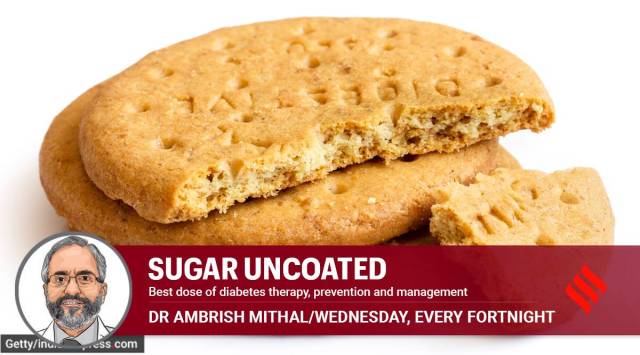Why your blood sugar is spiking because of that digestive biscuit: Choose nuts, seeds or fruit for snacking
Digestive or diabetic-friendly biscuits are not calorie-free or necessarily healthy. They may contain just 15-20 per cent fewer calories than the regular variety and may encourage you to consume large portions, thinking that they are safe. Many of them are loaded with sugar. Follow the low-cal snack list below, says Dr Ambrish Mithal, Chairman of Endocrinology and Diabetes, Max Healthcare
 Many a time we snack out of sheer habit, for example munching on biscuits with our morning tea, or on reaching home after a busy day, even as the dinner is being served. (Photo: Getty Images/Thinkstock)
Many a time we snack out of sheer habit, for example munching on biscuits with our morning tea, or on reaching home after a busy day, even as the dinner is being served. (Photo: Getty Images/Thinkstock) The venerable gentleman sitting across the table was worried. Despite following the advice about his meals, walking regularly and taking all his medication, his HbA1c (a measure of long-term sugar control) would not drop below eight per cent. He was just unable to reach his target of seven per cent. Ignoring his protests (“I know all about diet, why should I meet the educator again?”) I forced him to get his diet reviewed. And the secret came tumbling out. He was having three “diabetes-friendly” biscuits daily with his morning tea, a bowl of namkeens at 11 am and two pieces of deep- fried mathri with his evening tea at 6 pm. He never thought that these snacks could affect his diabetes.
Snacks are an essential part of our life to take care of the gaps between big meals. Our usual urban lifestyle includes three major meals – breakfast, lunch and dinner – and two sets of snacks – mid-morning and early evening. But what about those with diabetes? It’s important to understand that the concept of a diabetic diet or snack has been abandoned in favour of “healthy” eating and the correct portion size to fit your daily calorie requirement. Having a large meal is not generally recommended as it provides a high carbohydrate load which can cause the sugar to spiral upwards. Smaller and more frequent meals are generally preferred. Besides, for people with diabetes who are on multiple medicines (especially suphonylureas or insulin), long gaps between meals can result in low blood sugar reactions (hypoglycemia). Snacks are thus a necessity for most people with diabetes.
That does not mean that munching on something or the other throughout the day, or raiding the fridge at night are healthy. Excess and uncontrolled snacking increases your calorie intake and causes blood sugar spikes. In particular, late night or midnight snacking is unphysiological and harmful for all, regardless of the presence or absence of diabetes. So, it’s all about the right snack, in the right amount, at the right time!
Let’s figure out how to achieve this goal.
HOW TO CHOOSE HEALTHY SNACKS
For a start, remember that the portion size matters, regardless of which snack you choose. In general nuts are a good source of healthy (monounsaturated and polyunsaturated) fats, as well as proteins. Typical healthy nuts include almonds, walnuts and pistachios. Makhana or fox nut is also a good option, as are soya nuts. Roasted chana (gram) is a great snack. Flaxseed, sesame seeds, chia seeds all are healthy options. Both nuts and seeds are rich in fibre too. The importance of portion control cannot be over emphasized since nuts are high in calories. Please avoid added sugar (honey coated almonds!), salt (salted pistachios), and oily/fried preparations (fried nuts). Alternatively, you could opt for a small fruit, wholegrain crackers or just a cup of plain yogurt.
In general, we have to ensure that our snack does not contain more than 15 gm of carbohydrates and has protein and fibre. Following this basic principle can help in making choices. Please check with your doctor or educator/nutritionist what fits into your overall meal plan, taking care not to exceed your daily carbohydrate allowance.
EXAMPLES OF SNACKS BASED ON CALORIE CONTENT
Five Very low calorie snacks (<50 cals)
· 1 small apple (around 85g): 37 cals
· 80g blueberries: 32 cals
· 1 peach (around 138g): 46 cals
· 1 buckwheat dosa (45cals)
· 25g cottage cheese (26 cals) with a quarter of a cucumber (11 cals): 37 cals
5 Low calorie snacks (50-100 cals)
· 100 g cherries with 50g natural yogurt: 90 cals ( Fruit Yogurt)
· 10 almonds: 61 cals
· 1 boiled egg: 79 cals
· 1 serve Khaman Dhokla -80 cals
· 1 cup (25 gm) of roasted makhana -90 cals
The challenge in snacking is to exercise control. Many a time we snack out of sheer habit, for example munching on biscuits with our morning tea, or on reaching home after a busy day, even as the dinner is being served. Some of us also snack when we are feeling anxious or low, a phenomenon commonly known as emotional or comfort eating. Every time you feel the urge coming on, pause, take a deep breath and figure out if you are really hungry. Divert your mind to some other activity that has nothing to do with food. Read a book, put on some music, or chat with someone you like.
If the urge is overpowering, substitute your regular snack with a healthy one. Avoid chips, go for roasted seeds instead. Avoid breads and dips, choose carrots and hummus. Roasted peanuts are a better option than rusks and biscuits. And if sugar craving is killing you, have a square of dark rather than milk chocolate, drop ice cream and go for berries and yogurt instead.
WHAT ABOUT DIABETIC-FRIENDLY SNACKS?
Snacks labelled as “diabetic-friendly” are not calorie-free or necessarily healthy. They may contain just 15-20 per cent fewer calories than the regular variety and may encourage you to consume large portions, thinking that they are safe. A big culprit in this group are the numerous “digestive”/”healthy” “diabetes friendly” biscuits, many of which are loaded with sugar.
The key is to read labels carefully and remember that portion size (what you eat) and serving size (mentioned on the label) are two different measures. With a little bit of guidance and some common sense, you can enjoy your snacks and keep your sugar in check too!



- 01
- 02
- 03
- 04
- 05




























